Stephan J. Garbin
Synthetic Prior for Few-Shot Drivable Head Avatar Inversion
Jan 12, 2025Abstract:We present SynShot, a novel method for the few-shot inversion of a drivable head avatar based on a synthetic prior. We tackle two major challenges. First, training a controllable 3D generative network requires a large number of diverse sequences, for which pairs of images and high-quality tracked meshes are not always available. Second, state-of-the-art monocular avatar models struggle to generalize to new views and expressions, lacking a strong prior and often overfitting to a specific viewpoint distribution. Inspired by machine learning models trained solely on synthetic data, we propose a method that learns a prior model from a large dataset of synthetic heads with diverse identities, expressions, and viewpoints. With few input images, SynShot fine-tunes the pretrained synthetic prior to bridge the domain gap, modeling a photorealistic head avatar that generalizes to novel expressions and viewpoints. We model the head avatar using 3D Gaussian splatting and a convolutional encoder-decoder that outputs Gaussian parameters in UV texture space. To account for the different modeling complexities over parts of the head (e.g., skin vs hair), we embed the prior with explicit control for upsampling the number of per-part primitives. Compared to state-of-the-art monocular methods that require thousands of real training images, SynShot significantly improves novel view and expression synthesis.
Nuvo: Neural UV Mapping for Unruly 3D Representations
Dec 11, 2023Abstract:Existing UV mapping algorithms are designed to operate on well-behaved meshes, instead of the geometry representations produced by state-of-the-art 3D reconstruction and generation techniques. As such, applying these methods to the volume densities recovered by neural radiance fields and related techniques (or meshes triangulated from such fields) results in texture atlases that are too fragmented to be useful for tasks such as view synthesis or appearance editing. We present a UV mapping method designed to operate on geometry produced by 3D reconstruction and generation techniques. Instead of computing a mapping defined on a mesh's vertices, our method Nuvo uses a neural field to represent a continuous UV mapping, and optimizes it to be a valid and well-behaved mapping for just the set of visible points, i.e. only points that affect the scene's appearance. We show that our model is robust to the challenges posed by ill-behaved geometry, and that it produces editable UV mappings that can represent detailed appearance.
BlendFields: Few-Shot Example-Driven Facial Modeling
May 12, 2023
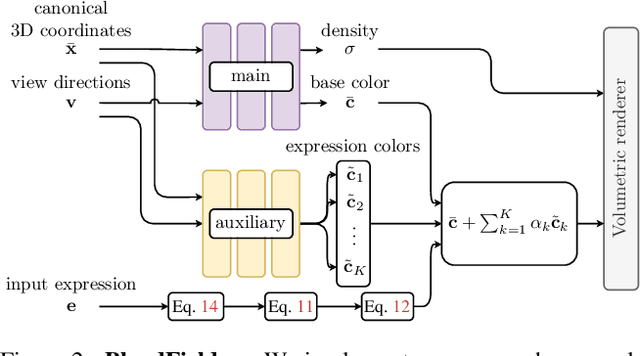
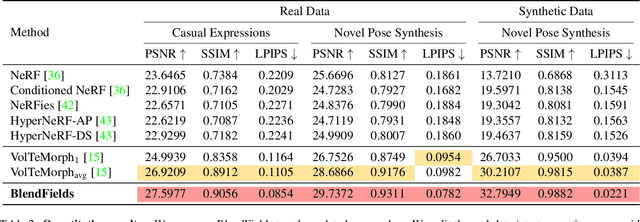
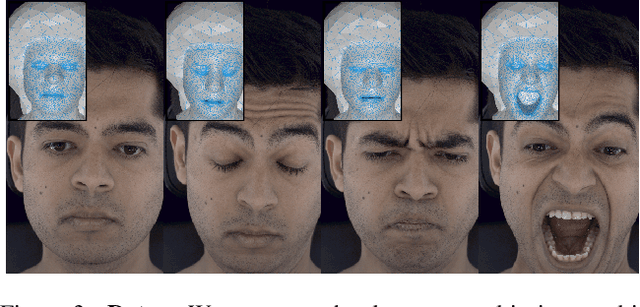
Abstract:Generating faithful visualizations of human faces requires capturing both coarse and fine-level details of the face geometry and appearance. Existing methods are either data-driven, requiring an extensive corpus of data not publicly accessible to the research community, or fail to capture fine details because they rely on geometric face models that cannot represent fine-grained details in texture with a mesh discretization and linear deformation designed to model only a coarse face geometry. We introduce a method that bridges this gap by drawing inspiration from traditional computer graphics techniques. Unseen expressions are modeled by blending appearance from a sparse set of extreme poses. This blending is performed by measuring local volumetric changes in those expressions and locally reproducing their appearance whenever a similar expression is performed at test time. We show that our method generalizes to unseen expressions, adding fine-grained effects on top of smooth volumetric deformations of a face, and demonstrate how it generalizes beyond faces.
VolTeMorph: Realtime, Controllable and Generalisable Animation of Volumetric Representations
Aug 01, 2022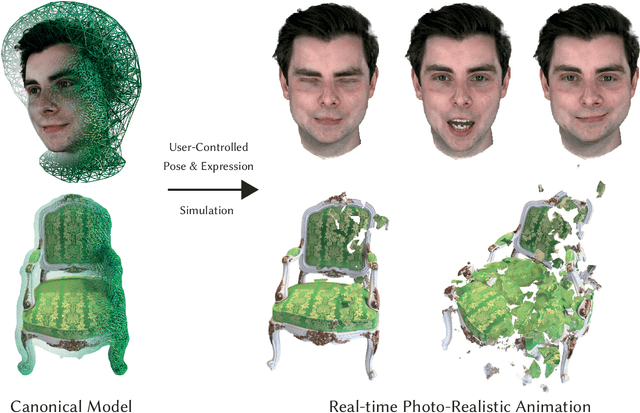
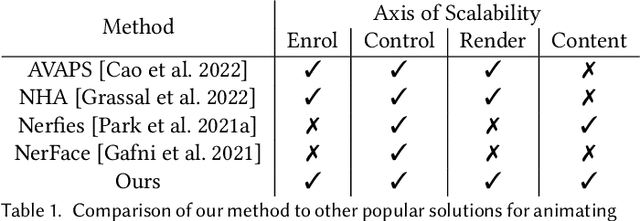
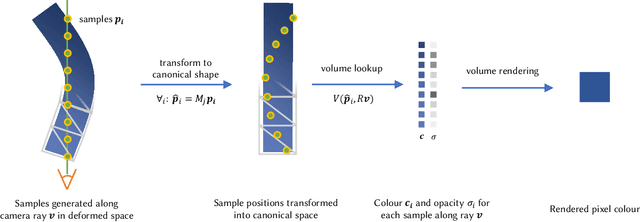
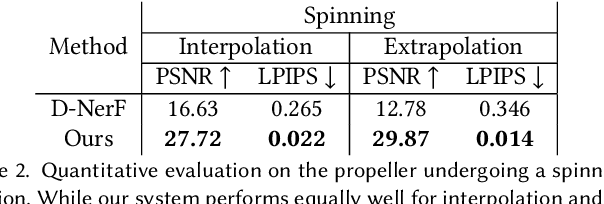
Abstract:The recent increase in popularity of volumetric representations for scene reconstruction and novel view synthesis has put renewed focus on animating volumetric content at high visual quality and in real-time. While implicit deformation methods based on learned functions can produce impressive results, they are `black boxes' to artists and content creators, they require large amounts of training data to generalise meaningfully, and they do not produce realistic extrapolations outside the training data. In this work we solve these issues by introducing a volume deformation method which is real-time, easy to edit with off-the-shelf software and can extrapolate convincingly. To demonstrate the versatility of our method, we apply it in two scenarios: physics-based object deformation and telepresence where avatars are controlled using blendshapes. We also perform thorough experiments showing that our method compares favourably to both volumetric approaches combined with implicit deformation and methods based on mesh deformation.
FastNeRF: High-Fidelity Neural Rendering at 200FPS
Apr 15, 2021
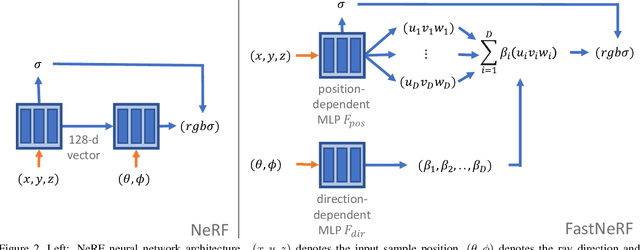

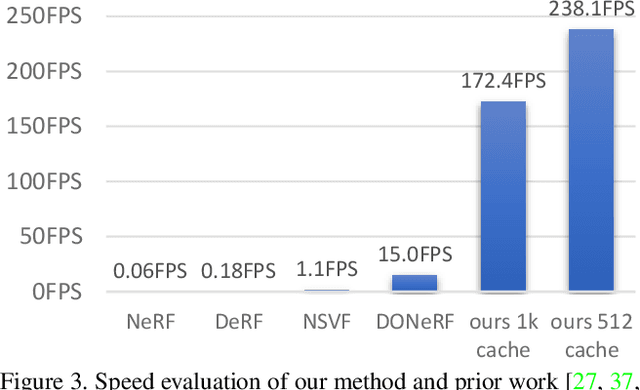
Abstract:Recent work on Neural Radiance Fields (NeRF) showed how neural networks can be used to encode complex 3D environments that can be rendered photorealistically from novel viewpoints. Rendering these images is very computationally demanding and recent improvements are still a long way from enabling interactive rates, even on high-end hardware. Motivated by scenarios on mobile and mixed reality devices, we propose FastNeRF, the first NeRF-based system capable of rendering high fidelity photorealistic images at 200Hz on a high-end consumer GPU. The core of our method is a graphics-inspired factorization that allows for (i) compactly caching a deep radiance map at each position in space, (ii) efficiently querying that map using ray directions to estimate the pixel values in the rendered image. Extensive experiments show that the proposed method is 3000 times faster than the original NeRF algorithm and at least an order of magnitude faster than existing work on accelerating NeRF, while maintaining visual quality and extensibility.
High Resolution Zero-Shot Domain Adaptation of Synthetically Rendered Face Images
Jun 26, 2020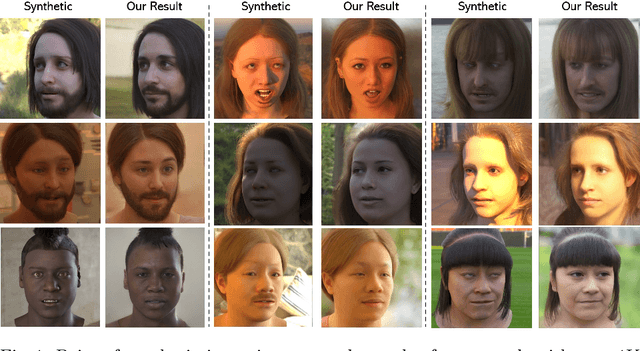

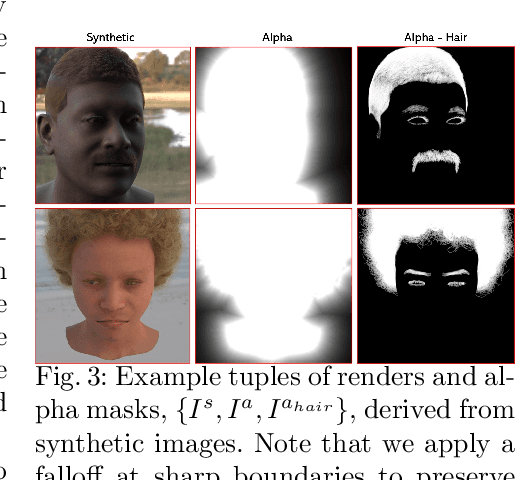
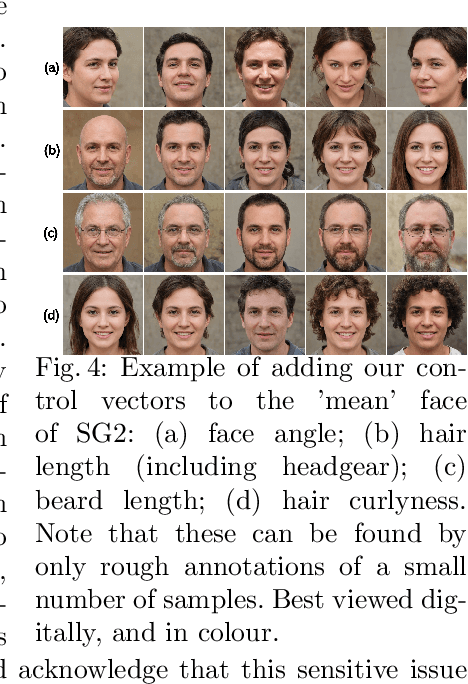
Abstract:Generating photorealistic images of human faces at scale remains a prohibitively difficult task using computer graphics approaches. This is because these require the simulation of light to be photorealistic, which in turn requires physically accurate modelling of geometry, materials, and light sources, for both the head and the surrounding scene. Non-photorealistic renders however are increasingly easy to produce. In contrast to computer graphics approaches, generative models learned from more readily available 2D image data have been shown to produce samples of human faces that are hard to distinguish from real data. The process of learning usually corresponds to a loss of control over the shape and appearance of the generated images. For instance, even simple disentangling tasks such as modifying the hair independently of the face, which is trivial to accomplish in a computer graphics approach, remains an open research question. In this work, we propose an algorithm that matches a non-photorealistic, synthetically generated image to a latent vector of a pretrained StyleGAN2 model which, in turn, maps the vector to a photorealistic image of a person of the same pose, expression, hair, and lighting. In contrast to most previous work, we require no synthetic training data. To the best of our knowledge, this is the first algorithm of its kind to work at a resolution of 1K and represents a significant leap forward in visual realism.
CONFIG: Controllable Neural Face Image Generation
May 12, 2020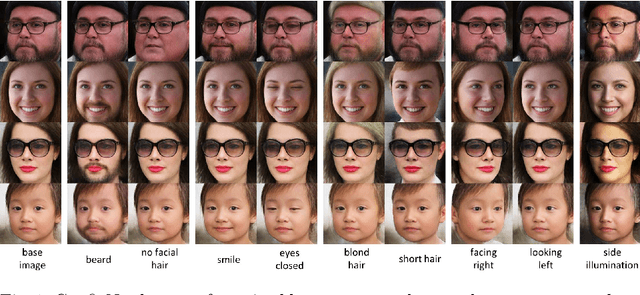
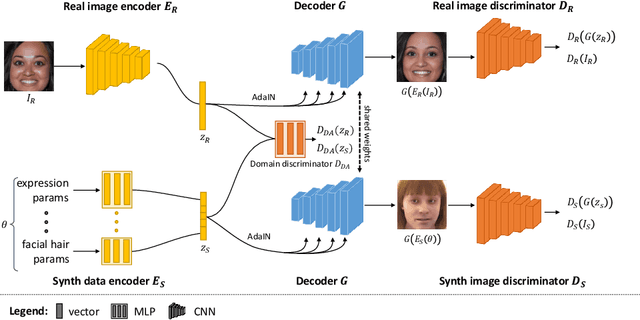


Abstract:Our ability to sample realistic natural images, particularly faces, has advanced by leaps and bounds in recent years, yet our ability to exert fine-tuned control over the generative process has lagged behind. If this new technology is to find practical uses, we need to achieve a level of control over generative networks which, without sacrificing realism, is on par with that seen in computer graphics and character animation. To this end we propose ConfigNet, a neural face model that allows for controlling individual aspects of output images in semantically meaningful ways and that is a significant step on the path towards finely-controllable neural rendering. ConfigNet is trained on real face images as well as synthetic face renders. Our novel method uses synthetic data to factorize the latent space into elements that correspond to the inputs of a traditional rendering pipeline, separating aspects such as head pose, facial expression, hair style, illumination, and many others which are very hard to annotate in real data. The real images, which are presented to the network without labels, extend the variety of the generated images and encourage realism. Finally, we propose an evaluation criterion using an attribute detection network combined with a user study and demonstrate state-of-the-art individual control over attributes in the output images.
OpenEDS: Open Eye Dataset
May 17, 2019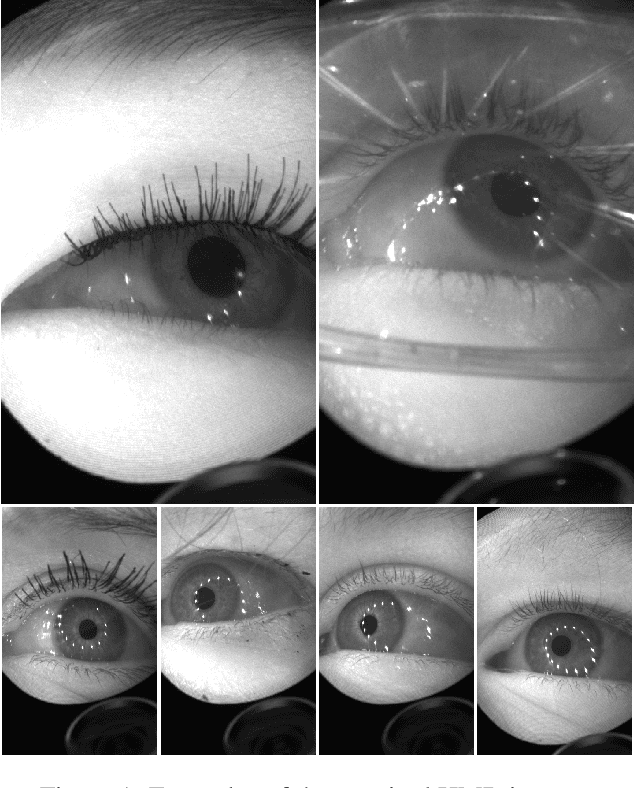

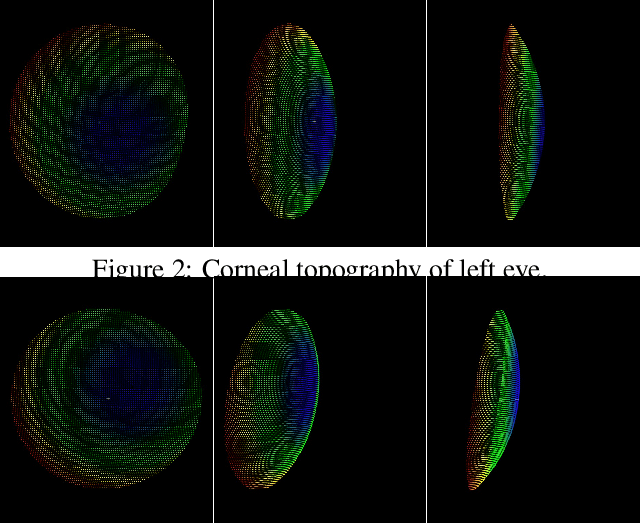

Abstract:We present a large scale data set, OpenEDS: Open Eye Dataset, of eye-images captured using a virtual-reality (VR) head mounted display mounted with two synchronized eyefacing cameras at a frame rate of 200 Hz under controlled illumination. This dataset is compiled from video capture of the eye-region collected from 152 individual participants and is divided into four subsets: (i) 12,759 images with pixel-level annotations for key eye-regions: iris, pupil and sclera (ii) 252,690 unlabelled eye-images, (iii) 91,200 frames from randomly selected video sequence of 1.5 seconds in duration and (iv) 143 pairs of left and right point cloud data compiled from corneal topography of eye regions collected from a subset, 143 out of 152, participants in the study. A baseline experiment has been evaluated on OpenEDS for the task of semantic segmentation of pupil, iris, sclera and background, with the mean intersectionover-union (mIoU) of 98.3 %. We anticipate that OpenEDS will create opportunities to researchers in the eye tracking community and the broader machine learning and computer vision community to advance the state of eye-tracking for VR applications. The dataset is available for download upon request at https://research.fb.com/programs/openeds-challenge
Interpretable Transformations with Encoder-Decoder Networks
Oct 19, 2017



Abstract:Deep feature spaces have the capacity to encode complex transformations of their input data. However, understanding the relative feature-space relationship between two transformed encoded images is difficult. For instance, what is the relative feature space relationship between two rotated images? What is decoded when we interpolate in feature space? Ideally, we want to disentangle confounding factors, such as pose, appearance, and illumination, from object identity. Disentangling these is difficult because they interact in very nonlinear ways. We propose a simple method to construct a deep feature space, with explicitly disentangled representations of several known transformations. A person or algorithm can then manipulate the disentangled representation, for example, to re-render an image with explicit control over parameterized degrees of freedom. The feature space is constructed using a transforming encoder-decoder network with a custom feature transform layer, acting on the hidden representations. We demonstrate the advantages of explicit disentangling on a variety of datasets and transformations, and as an aid for traditional tasks, such as classification.
Harmonic Networks: Deep Translation and Rotation Equivariance
Apr 11, 2017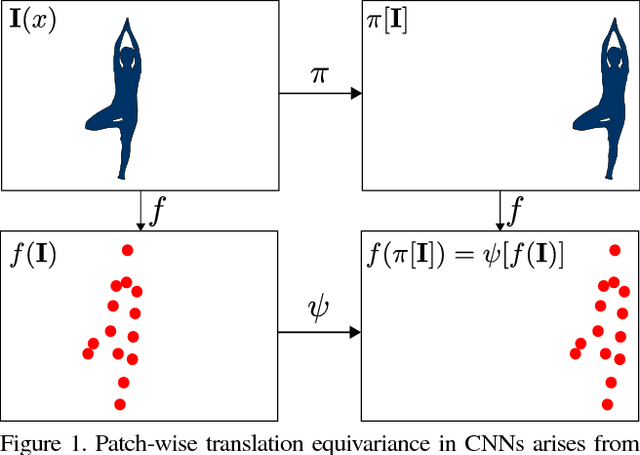
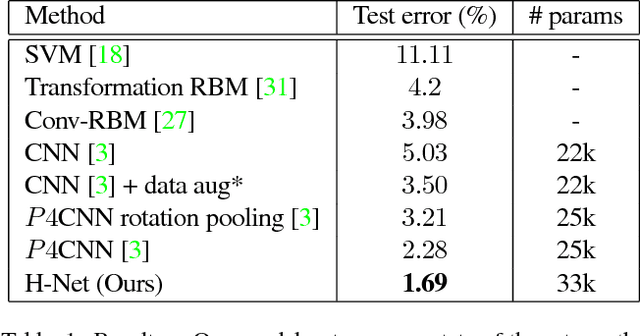
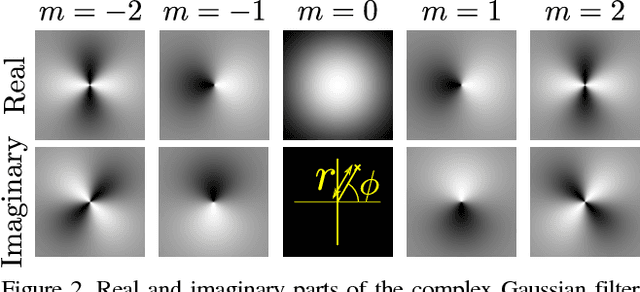
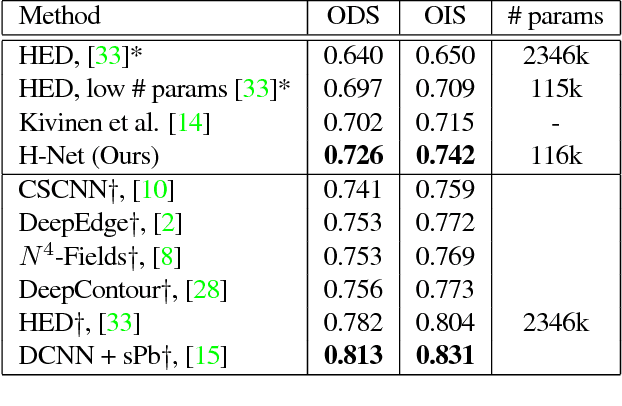
Abstract:Translating or rotating an input image should not affect the results of many computer vision tasks. Convolutional neural networks (CNNs) are already translation equivariant: input image translations produce proportionate feature map translations. This is not the case for rotations. Global rotation equivariance is typically sought through data augmentation, but patch-wise equivariance is more difficult. We present Harmonic Networks or H-Nets, a CNN exhibiting equivariance to patch-wise translation and 360-rotation. We achieve this by replacing regular CNN filters with circular harmonics, returning a maximal response and orientation for every receptive field patch. H-Nets use a rich, parameter-efficient and low computational complexity representation, and we show that deep feature maps within the network encode complicated rotational invariants. We demonstrate that our layers are general enough to be used in conjunction with the latest architectures and techniques, such as deep supervision and batch normalization. We also achieve state-of-the-art classification on rotated-MNIST, and competitive results on other benchmark challenges.
 Add to Chrome
Add to Chrome Add to Firefox
Add to Firefox Add to Edge
Add to Edge